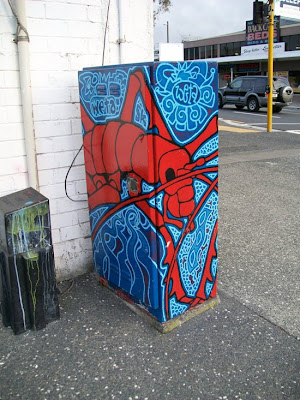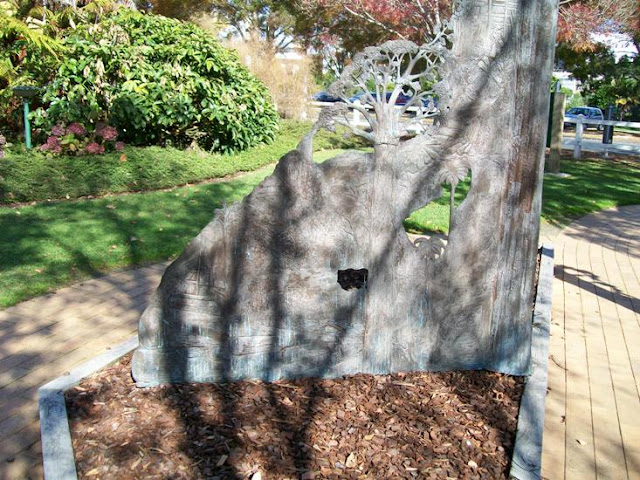As I've mentioned before, my quest this year is to complete a bit of a history of Henderson's Mill, called Timber's Fortune. This means that most of my visits to Mill Cottage, the base of operations for the West Auckland Historical Society, tend to involve discussions with local historian Ben Copedo. Who, one day recently, referred to McLeod's Crossing.
Which I hadn't heard of before.
Righto. That was on my list of places I needed to see, next time I was in the area. Which was last Monday, where I decided to take the other route along Edmonton Road way to Mill Cottage, instead of the more direct Ratanui Street route.
On the way -- other things were found. Always a mark of a good journey, when other things are discovered along the way.
Newey's Corner (right in the photo), 1930s, from the information plaque in the reserve on the corner of Edmonton and Great North Roads. There used to be a house there, owned by Eileen Newey, a schoolteacher. When she died, the Henderson Borough Council got the land and the house.
The land is now a pretty little reserve and walkway beside the Oratia Stream. The house, put up on offer to any community group who wanted it in 1987 ...
Image: Western Leader, 28 September 1987
... but somehow the house ended up at Western Springs, beside the Auckland Horticultural Society building, Great North Road. Almost opposite Motions Road. I still don't know how, or why, but I'm working on it. Any information gratefully appreciated.
Update 30 December 2011: I now know -- but too late for the fate of the cottage.
See here.
The Oratia Stream, from the Alderman Drive bridge (built 1984).
Next, a point of contention still in Henderson's local history, although I'm not sure why there is still so much utterly mad misinformation floating around about it, after all this time: the Falls Hotel.

This was built, originally, in 1873, on Great North Road close to Railside Avenue. So says Ben Copedo, so says enough contemporary newspaper references to surely win the argument. But, while there is still strange bad history around like Graeme Murdoch's
Field Guide to Auckland (giving an unexplained date of 1856) and the
website for The Falls itself (1854) -- folks will still think this is one of the oldest hotels around. And have the wrong information to boot. Why does the 1850s date refuse to die? In 1854 (early, and
before Long John McLeod leased the mill from Henderson & Macfarlane), there was a survey done by Commander Drury on
HMS Pandora of the Waitemata River and its tributaries (Ref. NZ Map 3909, Auckland City Libraries'
Maps Online.) It showed some blotches on the Opanuku Stream, plus the word "Mill" beside a larger blotch. This couldn't be the saw mill, the historians said, because it's on the wrong side! Has to be an error. Hmm. Wonder what it might be. Oh, how about a hotel? Yes, it must be the Oratia Hotel, built 1854, by Long John McLeod who hadn't quite reached the place just then ...
Actually, there's nothing against the original saw-mill having been on the other side, as Drury has it, because McLeod had to build a new mill by bracing up the old one to cut the timber ... Ah, well. Heritage urban legends are hard to kill.
Some more shots of the hotel, altered greatly since 1873, and now shifted to Alderman Drive (since 1996). They may try to link the hotel to "Long" John McLeod, but it's "Shepherd" John McLeod who built it, was the first publican there, and now it's on the farm he ran from the 1860s, Mill Farm. Very apt.
A band rotunda was added to the hotel's landscape on Falls Park in 1999.
This is a sculpture by Roderick Burgess, installed 1998 at Falls Park, showing the history of primary and secondary industry in Henderson.
Gumdiggers.
Winemakers.
Click to see more detail. Email me if you'd like to see higher res shots. This sculpture is very detailed.
I couldn't find the Volunteer Camelia (hopefully, it hasn't been ripped out or vandalised).
But I did find the Rotary Peace Garden, dedicated in February 2000.
And then, going over a small wooden bridge ...
... I realised I'd found the subject of the search: McLeod's Crossing. The only way I knew was because of a small, circular bit of bronze set in the centre of the walkway. I nearly missed it.
A bit of a shame, as this is a crossing to the Mill Farm, closely linked with "Shepherd" John McLeod, hotelier, farmer, horse-breeder, Highway Board member, and one of the pioneers of the district.
The bridge was designed by Karekare artist John Edgar, and was reported at its opening in 2000 to reflect "elements of a kauri tree". Not sure how that reflects back on "Shepherd" John McLeod, but -- at least it does mark, in a way, the path to his farm. They probably didn't want to put anything more than the bit of brass in place with a name on, in case folks started arguing over this bit of Henderson's history as well ...






















































